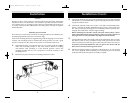
7
Installation (Cont.)
Ignition Noise Interference
Use of a mobile receiver at low signal levels is normally limited by the presence
of electrical noise. The primary source of noise in automobile installations is from
the alternator and ignition system in the vehicle. Under most operating conditions,
when signal level is adequate, the background noise does not present a serious
problem. Also, when extremely low level signals are being received, the transceiver
may be operated with vehicle engine turned off. The unit requires very little
current and therefore will not significantly discharge the vehicle battery.
Even though the COBRA21 LTD ST has an automatic noise limiter, in some instal-
lations ignition interference may be high enough to make good communications
impossible. The electrical noise may come from several sources. Many possibili-
ties exist and variations between vehicles require different solutions to reduce the
noise. Consult your COBRAdealer or a 2-way radio technician for help in locat-
ing and correcting the source of severe noise.
Base Station Operation (Operation from 120VAC, House Current)
To operate your transceiver from your home or office, using the regular house
current as the power source, you will require a 12 VDC power pack that has been
specially designed for the purpose. It is available as optional equipment from
your COBRAdealer. It consists of a 120-volt, 60 Hz AC to 12-volt DC power con-
verter that delivers the required power for the operation of the transceiver. Simply
connect the red (+) and black ( - ) leads of the transceiver to the corresponding
terminals of the power packs.
DO NOT ATTEMPT TO OPERATE THIS TRANSCEIVER BY
CONNECTING DIRECTLY TO 120 VAC.
Temporary Mobile Operation
To operate your COBRA transceiver from a car on a temporary basis, you may
want to purchase an optional cigar lighter adapter from your COBRAdealer. This
adapter and a magnetic mount antenna allow you to quickly "install" your trans-
ceiver for temporary use.
6
CB Antenna
Since the maximum allowable power output of the transmitter is limited by the
FCC, the antenna is one important factor affecting transmission distance. Only a
properly matched antenna system will allow maximum power transfer from the
50 ohm transmission line to the radiating element. In mobile installations (cars,
trucks, boats, etc.), an antenna system that is non-directional should be used.
A vertically polarized, quarter-wavelength whip antenna provides the most reli-
able operation and greatest range. Shorter, loaded-type whip antennas are more
attractive, compact and adequate for applications where the maximum possible
distance is not required. Also, the loaded whips do not present the problems of
height imposed by a full quarter-wavelength whip.
Mobile whip antennas utilize the metal body of the vehicle as a ground plane.
When mounted at a corner of the vehicle they are slightly directional, in the direc-
tion of the body of the vehicle. For all practical purposes, however, the radiation
pattern is nondirectional. The slight directional characteristic will be observed
only at extreme distances. Astandard antenna connector (type SO-239) is provided
on the transceiver for easy connection to a standard PL 259 cable termination.
Cobra loaded type antenna models are highly recommended for most installa-
tions. Consult your Cobra dealer for further details, or call 773-889-3087 and
speak to a Cobra customer representative.
When installed in a boat, the transceiver will not operate at maximum eff i c i e n c y
without a ground plate, unless the vessel has a steel hull. Before installing the trans-
ceiver in a boat, consult your dealer for information re g a rding an adequate gro u n d-
ing system and prevention of electrolysis between fittings in the hull and water.
3-Way Combination Antennas are available which allow operation of all three
bands (AM-FM & CB), using a single antenna. However, use of this type of
antenna usually results in less than normal transmit and receive range when
compared to a standard-type "Single Band" antenna designed for CB only. The
quality of reception of radio signals is highly dependent on the antenna sys-
tem. Call 773-889-3087 for further information.
Installation (Cont.)
21LTDST.MANUAL.REV.QX 9/25/98 10:59 AM Page 9













